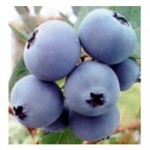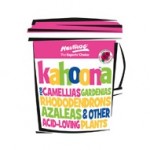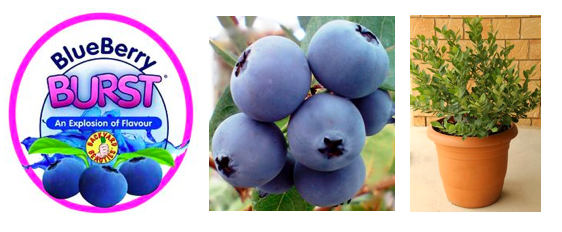 I’m pretty fond of blueberry pie and blueberry muffins (but then again … who isn’t?) so it was pretty obvious that I should start growing blueberries in my home garden to resource my “dietary needs” of pie and muffins.
I’m pretty fond of blueberry pie and blueberry muffins (but then again … who isn’t?) so it was pretty obvious that I should start growing blueberries in my home garden to resource my “dietary needs” of pie and muffins.
I’d seen a new variety of blueberry called Blueberry Burst that was suitable for growing in pots and as a compact grower for the garden. So I bought a few blueberry plants last year and planted them out in my garden. They were marketed as the biggest blueberry ever, being 3 times the size of normal blueberries. Woo hoo! I thought I was on a winner.
Sadly, my blueberry bushes were somewhat underwhelming when it came to harvesting them last year. The plants produced a good number of flowers and fruit but the size of the blueberries was definitely nowhere near 3 times the size of normal blueberries. In fact, I think most were on par with (if not smaller) than the ones I’d seen in the supermarket.
I’m not one to give up, so I was happy to see the blueberry grower at the Melbourne International Flower and Garden Show earlier this year. I took the opportunity to let him know about my less than desirable results and asked if he had any suggestions for me.
“You’ve really got to keep up the potassium.” He said. “Most people don’t understand the need for potassium.”
The information he gave me was gold (or at least blue in this case). I DO understand the need for potassium, but had underestimated the quantity. Now I know how to grow blueberries properly.
Plants grow with a balance of nitrogen (for good leaf and shoot development) and phosphorus (for good root development) among other vital trace elements. When the plant flowers or produces fruit, it needs extra supplies of potassium to support fruit set.
So I decided that my blueberry bed needed a bit of an overhaul to ensure the best supply of blueberries (and consequently blueberry pies and muffins) for next season.
I got onto this in March this year, first, with a check of the soil pH. I knew I needed to address this because I had signs of “interveinal chlorosis” (i.e. yellowing between the veins of the leaf with the veins still remaining green) on the older leaves on my blueberry bushes. The leaves were also brown and crispy on the ends. This is a classic sign of potassium deficiency.
By the way, if you are wondering how different nutrient deficiencies display themselves, then here is a good list of signs and symptoms for you.
Blueberry plants are acid lovers, so they like to grow in a soil that is 4 – 5 on the pH scale. Most plants prefer a neutral soil around 7. If a plant is grown in soil with the wrong pH level, it cannot access the nutrients that it needs, regardless of how fertile the soil may be. The nutrients simply get locked up. So my first step was to apply some sulphur to the soil and scratch it into the surface, to bring the pH down a bit. My pH tests had shown that the soil was too alkaline so sulphur is the ideal remedy.
If you grow blueberries in a pot, then choose an Azalea and Camellia potting mix. It is specifically formulated for acid loving plants, like blueberry plants. If you have planted it already in a general potting mix, then do exactly what I have done with the sulphur and scratch it into the surface of the soil in your pots.
I could start to see the difference after about a month. It takes time for microbes to break down the sulphur and adjust soil pH levels, so be patient.
Then I needed to boost the potassium. Potassium comes in the form of “potash” and home made compost that’s been made with banana skins, citrus peelings (yes you can put them in your compost) and general veggie waste. Wood ash is also a good source of potassium but it can exacerbate the problem by increasing your pH (so avoid woodash for blueberry plants). Seaweed is also a good source of potassium.
 This time I chose to use a commercial brand of fertiliser: Neutrog Kahoona. It’s an organic based pellet fertiliser, specifically designed for acid lovers. It contains composted materials with a good level of organic carbon and is chemically boosted with potassium sulphate to promote flowers and fruiting. I watered it all in with a good splash of diluted seaweed solution.
This time I chose to use a commercial brand of fertiliser: Neutrog Kahoona. It’s an organic based pellet fertiliser, specifically designed for acid lovers. It contains composted materials with a good level of organic carbon and is chemically boosted with potassium sulphate to promote flowers and fruiting. I watered it all in with a good splash of diluted seaweed solution.
The results have been great. Now, in May, my blueberry plants are looking great. They’re deep green and loaded with flowers.
But, as the grower suggested, I can’t stop there. (This was possibly my fault last year, I pulled back too soon). I will continue now with a routine of monthly seaweed solution and a bi-monthly handful of Kahoona pellets, to keep my blueberry bushes going strong. This year I’m determined to get those huge blueberries on my plants as promised. And of course, followed by a few too many blueberry muffins. Life is too short to worry about calories!
Now can anyone suggest a good recipe for Blueberry Pie?






 Twitter
Twitter Facebook
Facebook
GREAT post- such thorough info- thank you!!
What time of the year do blueberry plants come into fruit in Sydney? Thanks for posting. My blueberry bush looks terrible but I’ll try the pottash and fertilizer.
You should be getting fruit from now on.
Thanks for this article. Just made a trip to the pine forest to collect pine needles to keep the soil acidic.
I put in the Northland variety last year. It’s colour during autumn was spectacular.
Nice work
Great Article. Thanks for the information. I have planted some blueberries and have finally got some fruit from them. Not much but a little. I know my soil is needing to be more acidic.
Glad you found it helpful. May your blueberries be abundant.
Hi! Did your blueberries continue to thrive with the Kahoona fertilizer, or did you find you had to amend with another product? Any tips you can pass my way will be hugely appreciated. Thank you!
Hi Heather, yes the Kahoona treatment and seaweed solution did the trick. Just remember to make it a regular thing. Good luck.
Great read, detail and a heads up on what to do.
Thanks muchly